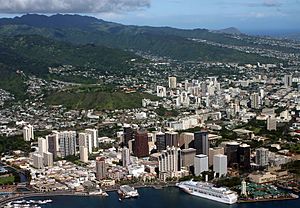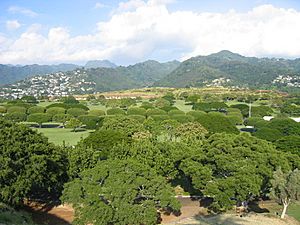Punchbowl Crater facts for kids
Punchbowl Crater is an old volcano in Honolulu, Hawaii. It's shaped like a big bowl! Inside this bowl is a special place called the National Memorial Cemetery of the Pacific.
How Punchbowl Crater Was Formed
This crater was made a very long time ago, about 75,000 to 100,000 years ago. It happened when hot lava burst through cracks in old coral reefs. These reefs used to reach the bottom of the Koolau Mountains.
Punchbowl Crater is a type of volcano called a "tuff cone." This means it was formed by explosive eruptions of ash and rock. It's also likely a monogenetic volcano, which means it only erupted one time.
The Meaning of "Puowaina"
The Hawaiian name for Punchbowl is "Puowaina." This name has a few meanings, but the most common one is "Hill of Sacrifice." This name connects to the crater's long history.
Long ago, Hawaiians used the crater as a special place. They offered sacrifices to their gods there. People who broke important rules were also brought to this spot.
Later, during the time of King Kamehameha the Great, cannons were placed at the top of the crater. These cannons were used to greet important visitors. They also fired to mark special events.
In the 1880s, people started to settle on the slopes of Punchbowl. In the 1930s, the crater was used as a shooting range for the Hawaii National Guard. Near the end of World War II, tunnels were dug into the crater's rim. These tunnels held big guns to protect Honolulu Harbor and Pearl Harbor.
A Special Cemetery Inside the Crater
In the late 1890s, some people thought Punchbowl would be a good place for a new cemetery. But this idea was turned down. People worried it might pollute the water. They also didn't like the idea of a "city of the dead" above a "city of the living."
About 50 years later, the United States Congress decided to create a national cemetery in Honolulu. There were two main rules for this:
- The War Department had to agree on the location.
- The land for the cemetery had to be given for free, not bought.
In 1943, the governor of Hawaii offered Punchbowl Crater for the national cemetery. However, the money set aside for it wasn't enough. So, the project was put on hold until after World War II.
By 1947, many people and groups wanted a permanent burial place in Hawaii. Thousands of World War II service members were waiting to be buried on the island of Guam. Because of this, the Army started planning the Punchbowl cemetery again. In February 1948, Congress approved the money, and construction began.





